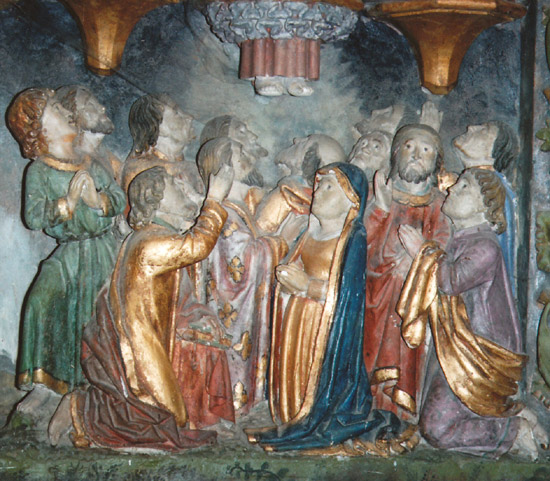Almighty God, whose blessed Son our Savior Jesus Christ ascended far above all heavens that he might fill all things: Mercifully give us faith to perceive that, according to his promise, he abides with his Church on earth, even to the end of the ages; through Jesus Christ our Lord, who lives and reigns with you and the Holy Spirit, one God, in glory everlasting. Amen.
Collect for Ascension Day from the 1979 BCP
For today’s feast we post a reflection by Michael Ramsey (1904-1988), the 100th Archbishop of Canterbury from 1961 until 1974, and a prayer from Meditative Prayers for Today by Adam Bittleston (1911-1989). Bittleston earned his degree in Oxford in philosophy, politics and economics. In 1935 he was ordained a priest in the Christian Community . He was a close friend of William Golding.
For the biblical writers and for much Christian thought in post- biblical times, heaven or the other world was a place beyond the sky. Thither Christ had gone up at his Ascension, and there the saints reigned with him in dazzling light. It was another world related to this world astronomically, which really meant that it was part of this world.
Yet within this language of locality, just because it was language about God, there was present something which strained it and turned it into the symbol of realities which transcended locality altogether: the supremacy of Christ everywhere, and the union of Christians with God through him. The right hand of God meant no local activity, but a symbol of God’s sovereign power. The Ascension of Christ meant a presence unrestricted: if he is here, he is there; if he is there, he is everywhere. God being “above” meant a relation no less describable as “within”. The spatial conception of the “other world” lingered, but the heart of Christian belief knew from the beginning that it was only using symbols for the God- Christ-mankind relationship beyond locality.
So the “otherness” of the other world is not that of a structure standing over against this world. It is the otherness of man’s life with God, invisible, present already, and leading to a destiny after death. Just as the approach to the belief in immortality is through belief in God (“God is the strength of my life and my portion for ever”), so man knows of and approaches the “other world” through fellowship with God, a fellowship which is the other world’s essential content.
That other world—heaven—has God’s own glory, reflected in his perfected children, as its very essence: quem nosse vivere est (whom to know is to live). Hence no language suffices to describe it, since to describe it is to describe God whose reflection it is.
Source : Margaret Duggan, ed., “Through the Year with Micheal Ramsey. Devotional Readings for Every Day”, London 1975, p. 100-101.
The prayer by Bittleston:

Depiction of the Ascension (1516) from the altar in the Notre Dame de la Houssaye chapel in Pontivy, Bretagne, France. Jesus is disappearing from the sight of the present. At the same time, however, he is among them (please note the figure in red clothing looking at us – it is him).
The clouds receive
The Risen Christ
That He may rule
The world of Life.Witness of Him
We seek in earth
Where waters bear
The spirits grace.The moving air
And songs of birds
Say in the light
He has a home.And blossoms feel
The loving flames
He sendeth them
As messengers.Between men’s hearts
Strengthen the love —
O Lord of bread,
Giver of wine!That in the world
Thou fillest now
As Spirit-Sun,
We lift our sight!




